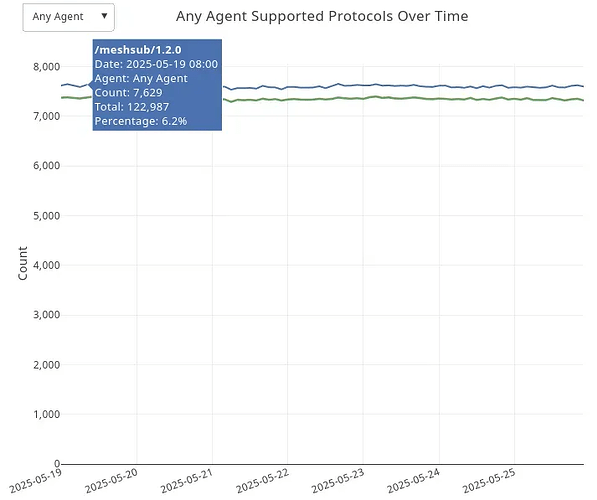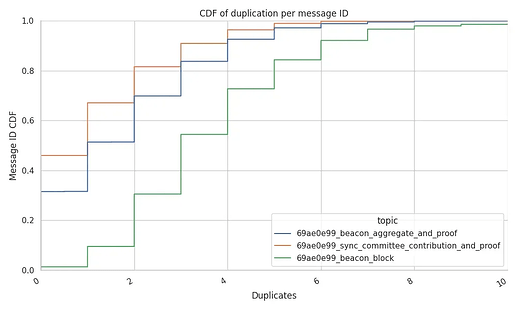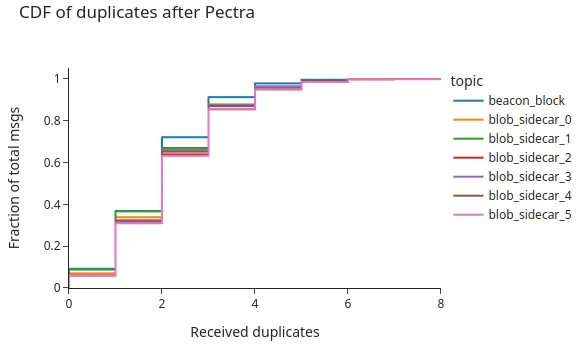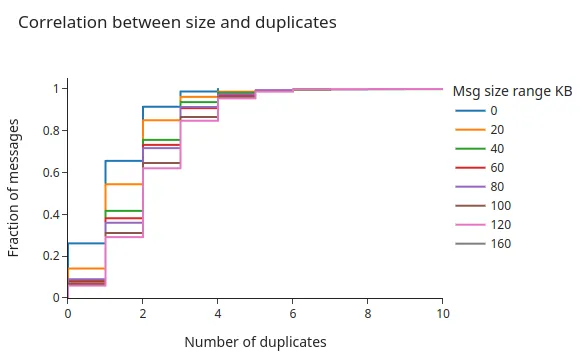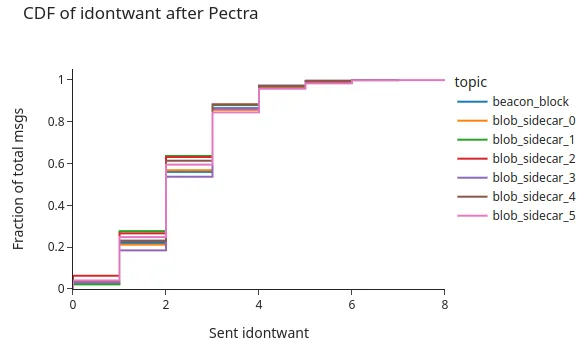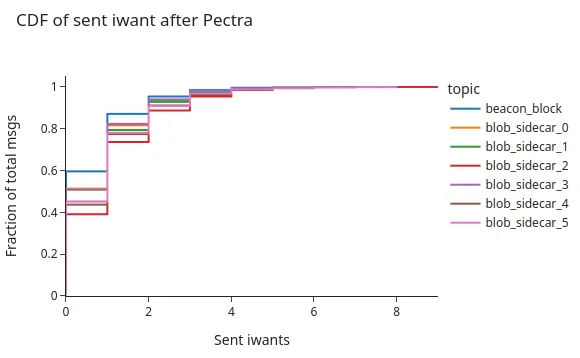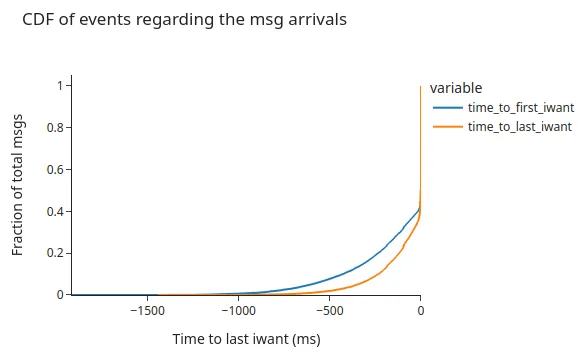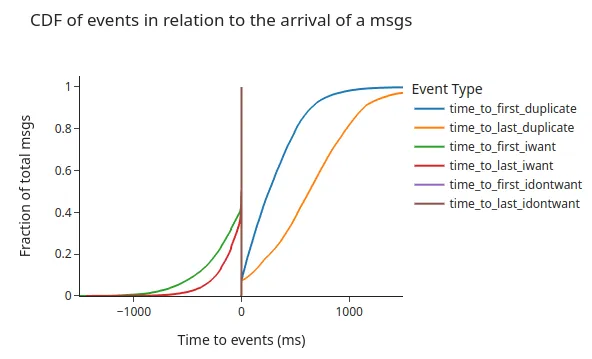Introduction
This work is a follow-up study of the original one we carried out on the number of duplicate messages, before the IDONTWANT message primitive was adopted:
Methodology
The data used to generate the following study was collected using our GossipSup listener hermes located in Sydney, Australia on 27/05/2025.
NOTE: We’ve also analysed the numbers from a second
hermesnode, located in California, US, to verify that numbers don’t differ much, which was indeed the case.
Adoption of IDONTWANTs
IDONTWANT messages have been part of the libp2p gossipsub spec for a while, but not all implementations supported them. In that sense, the Pectra upgrade wasn’t just a synchronous update to the Ethereum protocol—it also brought a significant increase in peers supporting the new control messages.
As of May 27th, from our weekly reports, we can observe that the majority of the network supports IDONTWANT (part of the meshsub/1.2.0 release). Only about 5% (roughly 400 nodes) are missing from the total discovered nodes.
Current level of duplicates
From our previous report when referring to the beacon_blocks topic, we found the following:
- there are almost no recorded messages without duplicates (1%-2%).
- 54% of the messages report the expected
3duplicates from the mesh- Taking a look at the tail of the CDF (shown in the dropdown plot further down), there are a few messages that were received up to 34 or 40 times.
Compared to these previous results, our current findings show that there’s a small but clear reduction of duplicates in topics with “large enough” messages (exceeding the 1Kb msg size), i.e., the beacon_block and beacon_blobs topics:
- There is an increase in the number of blocks with no duplicates from 2% (previously) to 9% after the addition of
IDONTWANT. - In the following graphs, we see a reduction of the mean, which now stays at 2 duplicates, instead of 3 previously. There are only 5% of the messages exceeding 4 duplicates.
- There’s a clear reduction in the tail of duplicates - we previously measured up to 34 or 40 duplicates in some edge cases, while now, the tail stops at 6-8 copies.
Before the IDONTWANTs:
After the IDONTWANTs:
Overall, what we see is that 98% of the duplicates arrive within the first second after receiving the first message, with 79% arriving within half a second, which extends for another 400ms until the last duplicate arrives.
Correlation between message size and number of duplicates
The following graph shows the time differences between the message arrival and the first duplicate per topic. In the figure, we can appreciate a clear difference between the two types of topics. The beacon_block generally has smaller messages than the blob_sidecar one, or at least the blob_sidecar topic is less stable in terms of message size (check the block size distribution further down).
Time to first duplicate:
Certainly, the next graph shows the CDF of the message size, where we see that beacon blocks are generally smaller than the sidecars.
There is, therefore, a small correlation between the size of the message and the number of duplicates. When looking at the following CDF chart, we see that larger messages do tend to get a higher number of copies, as they generally take a larger time to get transmitted over the wire.
NOTE: the size_range belongs to the range X to X+19 in KB
Example: size_range 0 includes [0kb, 20kb)
Number of IDONTWANTs
Methodology
The data used for this report comes from a single peer located in Australia, which is known to be out of the core of the network, with higher latency and lower bandwidth. However, checking with the results from a node based in the US, we found very similar results.
We aim to check if the IDONTWANT messages are actually getting sent, and the timing of sending these messages. These are both relevant points to see if there are any bottlenecks at the implementation level.
Results Summary
There is a clear reduction of duplicates, yet it is lower than we expected → we assumed that most of the duplicates would come through the mesh propagation ([D-2](Gossipsub Network Diameter Estimate))
However, we didn’t measure any sign of sent IDONTWANT messages on topics with messages below the threshold (1KB).
Interestingly, the following graph shows that our control node sent a similar number of IDONTWANT messages as the number of duplicates that we receive. Which could be an indicator of IDONTWANT not being as effective as we would expect.
One possible explanation is that we send IDONTWANTs on time to our mesh peers. However, we still receive the messages that we have just sent IDONTWANTs for, which indicates that the message was already on the wire.
When do duplicates arrive
Given the correlation between the number of sent IDONTWANT messages and the received duplicates, it is still unclear whether the IDONTWANTs are useful. The node could be sending the control messages with a small, but enough, delay from the arrival of the message. Thus, the following chart shows the time difference between the sending of IDONTWANT messages and the arrival of the first message. The figure shows that there is, indeed, no delay between the arrival of the message and the IDONTWANT notifications. The graph even shows some cases where control notification was sent before we were able to track the “delivery” of the message.
NOTE: We do see negative times as we read the message arrival by the Deliver notification, not when we received the message over the RPC.
What triggers duplicates after IDONTWANT messages
As mentioned above, interestingly, we still see duplicates that arrive after notifying the remote peer with an IDONTWANT.
The following chart shows the time difference between the notification of an IDONTWANT message and the received duplicate from the same peer. Where we can see that some implementations or versions don’t stop transmitting messages after receiving an IDONTWANT (rust-libp2p has ongoing work to address this issue, see GH issue and GH PR).
It’s worth noting that there is ongoing work to fix the case when a published RPC is queued and an IDONTWANT message arrives (issue). We believe this will help reduce the number of duplicates significantly.
To provide some numbers on how frequent this case is, we have:
30,607unique message IDs (blocks and blobs)63,735duplicated messages144,524sentIDONTWANTs25,201sentIWANTs14,255message IDs where we sent bothIWANTsandIDONTWANTs- out of
63,735total duplicates,44,875are from peers that got notified viaIDONTWANTmessages (~70% of duplicates)- sequence of events from the same peer that produced duplicates:
- (
44,875):msg_arrival>sent_idontwant>recv_duplicate
- (
- (
18)sent_iwant>msg_arrival>sent_idontwant>recv_duplicate- very few in relation to the total number of sent control messages
- In the overlap between IDONTWANTs and IWANTs, at least the go implementation doesn’t seem to be notifying remote IWANT-notified peers to stop the diffusion
- sequence of events from the same peer that produced duplicates:
Number of IWANTs
When looking at the number of IWANT messages sent by the hermes instance on the topics, what we see is that quite a few duplicates come as a reply to the IWANTs that we sent out.
Looking at when these messages were sent, we see that for around 60% of the (25,201) sent IWANTs were shared just 4 ms before the arrival of the block. Therefore, producing one duplicate message per sent IWANT. Clearly, this means that our node was almost done receiving the message when it sent the IWANT message out, which resulted in a duplicate.
The following graph shows that the full download of block and sidecar messages through IWANTs takes between 500ms and 1.5 seconds.
Summary
We see all the events summarised in the following chart, which is displayed as a relative time to the arrival of the message at the node we collect results from. That is, 0 is the point in time when our node received the message.
To provide some numbers of the events and their frequency, here is a summary:
30,607unique message IDs (blocks and blobs)63,735duplicated messages144,524sent IDONTWANTs25,201sent IWANTs14,255message IDs where we sent both IWANTs and IDONTWANTs44,875duplicates from peers that got notified via IDONTWANT messages (~70% of duplicates) →msg_arrival>sent_idontwant>recv_duplicate18,540duplicates from peers that requested the message through an IWANT (~29% of duplicates) →sent_iwant>msg_arrival>recv_duplicate(no sent IDONTWANT to cancel the IWANT)- (
18)sent_iwant>msg_arrival>sent_idontwant- very few cases when we tried to cancel the sent IWANT with an IDONTWANT → expected result at the go implementation, but defined by the spec.
12of those18cases, we received a duplicate
- (
Our recommendations
- Overall,
IDONTWANTsimprove the situation significantly, but become ineffective when:- The
msg_idwas already requested through anIWANT, in which case we don’t send anIDONTWANTmessage - The message is already in the pipe, and it doesn’t get cancelled
- The
- That said, there is still room for improvement in handling the control messages:
- Limit the number of IWANT messages sent as discussed at this issue and in Devcon SEA. As discussed earlier, we’ve seen that the node sends many redundant IWANT messages for a single message ID
- Delay the first IWANT message to avoid 60% of the distribution that was requested 10ms before the first message arrival, which we know would produce redundant copies.
- Cancel the reply of
IWANTupon receipt ofIDONTWANT, even if the message is already in transmission/on the wire.- This doesn’t seem to be the case for all the implementations (certainly not for Go).
- There is already a check for the messages we are about to publish (link). But many duplicates arrived after the sequence:
msg_arrival -> sent_idontwant -> recv_duplicate
- Cancel the reply of


